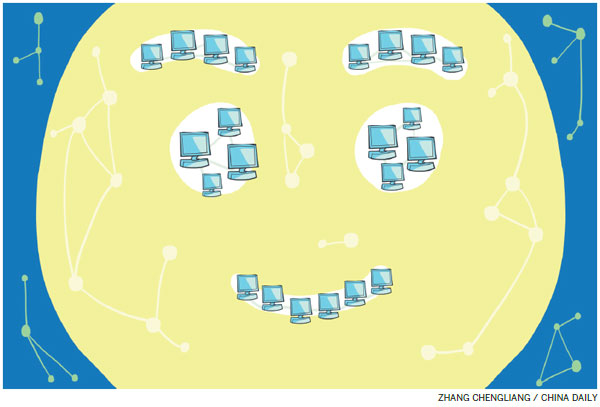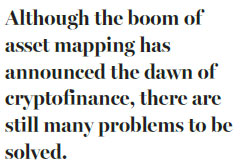The dawn of cryptofinance is upon us
Finding solutions to some key problems will usher in an exciting new era for the 'internet of value'
The "internet of value" is arising, in which value transactions can instantly occur anywhere, but financial applications on it are few. What are the reasons for the current status and future of cryptofinance - the finance on the internet of value?
The rise of the internet has brought fundamental improvement to people's daily lives and great transformations to many industries. But the impact of the internet on finance is not as big as it has been on traditional industries. So-called internet finance only helps such entities as banks, securities companies and exchanges to update some of their paperwork to electronic form, but the organizational forms have not yet experienced huge reconstruction. For example, although mobile payments are very popular in China, the underlying banking system remains the same. The interaction of values between organizations still mainly uses paper contracts.

The reason behind this is that contracts and signatures are extensively used in financial transactions. Although electronic contracts and electronic signatures can be used within an organization, they are not easily applied on a large scale among individuals and organizations. In order to prevent double-spending and make transactions automatic, central agencies are needed to provide bookkeeping services, such as digital ledgers, contracts and digital signatures. This is why, although they are neither flexible nor scalable, such services are still important in current societies.
The rise of blockchain means for the first time that centralized bookkeeping can be replaced by distributed ledgers on unstoppable peer-to-peer networks; people's handwriting signatures can be replaced by crypto signatures; and paper contracts can be automatized by smart contracts. It seems that blockchain technology is the one that will bring fundamental changes to traditional finance.

Traditional finance is unsatisfactory. The subprime mortgage crisis and the European debt crisis made people realize that the most developed countries can also have financial crises, and there are almost no effective solutions for them. Cryptofinance can solve the problems of trust, so it seems that people should embrace it wholeheartedly.
However, after the creation of the first blockchain, there was a long night for cryptofinance. From Jan 3, 2009, when the first application of cryptofinance went live, to the end of 2016, despite a large number of alternative currencies, no laudable cryptofinancial application had been created.
In essence, finance is defined by its functions. Although the forms of realizing financial functions are changing with time, financial functions themselves are stable. Financial functions can be generalized into two layers: The first includes the monetary functions, which include payment, pricing, value storage and international currency. The second layer includes the financial functions derived from the monetary functions, such as debt, equity, insurance, trust and derivatives, which are the reorganization of the financial assets in space and time.
The market capitalization of the world's traditional financial markets is quite large, with more than $300 trillion (243 trillion euros; £212 trillion) - nearly four times the global GDP. However, it is a little disappointing that at the beginning of 2017, eight years after the launch of bitcoin, the total market value of cryptocurrencies is only $17 billion, and applications in the second layer of financial functions are almost nonexistent.
An important event in 2017 was the boom of token generation. This is the second killer application of blockchain, following the payment application of blockchain. Thanks to the boom, by the end of 2017, the market capitalization of cryptocurrencies had reached $650 billion, an increase of nearly 40 times compared with that of the beginning of the year. The number of types of token has increased to more than 1,600. The phenomenon is a sign of the dawn of cryptofinance.
Tokenization is actually a counterpart of traditional securitization in the cryptofinancial world. With this artifact, any asset can be mapped onto a blockchain and be empowered with abilities such as digitization, peer-to-peer transaction and programmability.
These capabilities are so powerful that, from now on, people will be eager to map their assets onto blockchains. While some projects that have just finished proof of concept can issue their own tokens, physical assets such as diamonds, gold, oil and land will also be tokenized as values on the internet of value.
When many assets are tokenized and programmed by smart contracts, the internet of value will be gradually formed. Taking values on the internet of value into consideration, there are three types of value in the human world: 1) physical/atomic values and their corresponding tokens (the atomic assets that you can touch and their token representatives on blockchains) 2) digital values (the assets of data on the internet of information); and 3) gases: the tokens used as bookkeeping fees.

For physical values, bonding services are needed to give them representatives on the internet of value. These bonding services make sure that the transactions of the tokens on their blockchains are legitimate and effective in the physical world, and anyone who has some tokens can exercise his or her rights and be delivered the represented tokenized atomic assets.
Although the boom of asset mapping has announced the dawn of cryptofinance, there are still many problems to be solved. Among them, the multitoken smart contract problem and the multitrigger smart contract problem are the top two problems.
The multitoken smart contract problem, however, is also the problem of interoperability of the internet of values. It is a shame that the present tokens in the cryptofinancial world should be exchanged with one another in the traditional financial exchanges. Technologies such as side chains or relay chains are trying to solve these problems, but what people want is not atomic transfers but interaction of tokens within smart contracts in a programmable way.
The multitrigger smart contract problem is about the automation and off-chain data visit capability of smart contracts. Current smart contracts are not smart enough. They are not automatic: They can only be triggered by another transaction; otherwise they will not run automatically. They are also blind, because they cannot read off-chain data.
These two problems explain why there are almost no financial applications in the second layer of financial functions. We believe that those who can solve these problems can realize all the financial functionalities in the cryptofinancial world, and they will usher in an exciting new era of the cryptofinance for the internet of value.
The author is a lecturer at the Management School of Shanghai University, co-founder of public blockchain FUSION and a research fellow at the China Europe International Business School's Lujiazui International Finance Research Center. The views do not necessarily reflect those of China Daily.
(China Daily European Weekly 03/30/2018 page12)


















